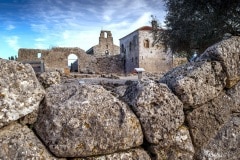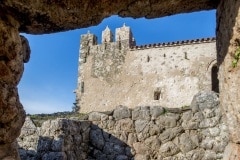
Nekromanteioν – Ephyra
The most famed necromancy of the ancient Greek world is located near the northwestern shores of Lake Acherousia, at the point where the rivers of Hades, Acheron and Cocytus, meet. Ancient texts refer to Lake Acherousia as the point of descent of the dead into Hades. At the Nekromanteion, the faithful went to meet the souls of the dead, as they were able to see into the future after having left their body. The Nekromanteion was first erected and operated during the Mycenaean Period (1200 BC), but many of the present ruins date back to the Hellenistic Period (323 BC onwards). In terms of architecture, the Acheron Nekromanteion can be compared to an imposing funerary monument, such as those built at the end of the 5th BC in Asia Minor and the East for the burial of prominent persons. The sanctuary operated uninterruptedly in this form for about two centuries. Following the conquest of Macedonia by the Romans, it was burned down in 167 BC, and ceased to operate. In the 1st century BC, when Roman settlers arrived in the plain of Acheron, the courtyard of the sanctuary was reinhabited. At the beginning of the 18th century, the monastery of Agios Ioannis Prodromos was built upon its ruins, and it is preserved to this day with the respective cemetery.
The earliest reference of the Acheron Nekromanteion is found in Homer’s Odyssey, where Circe advises Odysseus to descend to the Underworld to meet the blind seer, Teiresias and receive the omen on how to return home. Homer provides a fascinating account of the descent of the mortal Odysseus into the dark world of Hades.
The acoustics of the underground hall in the Acheron Nekromanteion is remarkable, and studies have been carried out by modern researchers.
Ephyra is close to the Nekromanteion, which is considered to be the oldest city of Epirus. It has a lot to show for, among others, the prehistoric and Mycenaean Acropolis, one of the most significant Bronze Age sites in Epirus. Ephyra was built by Thesprotians in the 14th – 13th century BC and it was already an important center of commerce from the time of Homer. The walls of Ephyra occupy two hills, while most of the ancient settlement was outside the castle. The city is referred to in the Odyssey as the meeting point of Telemachus and Athena, while Antifos set out from Ephyra to participate in the Trojan War as the leader of a 30-ship fleet.
Video
Virtual Tour





